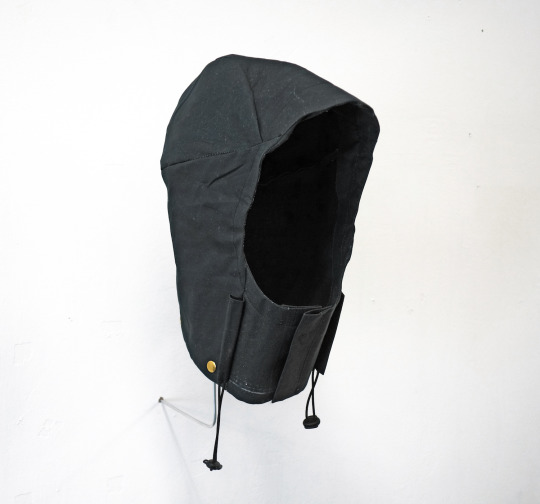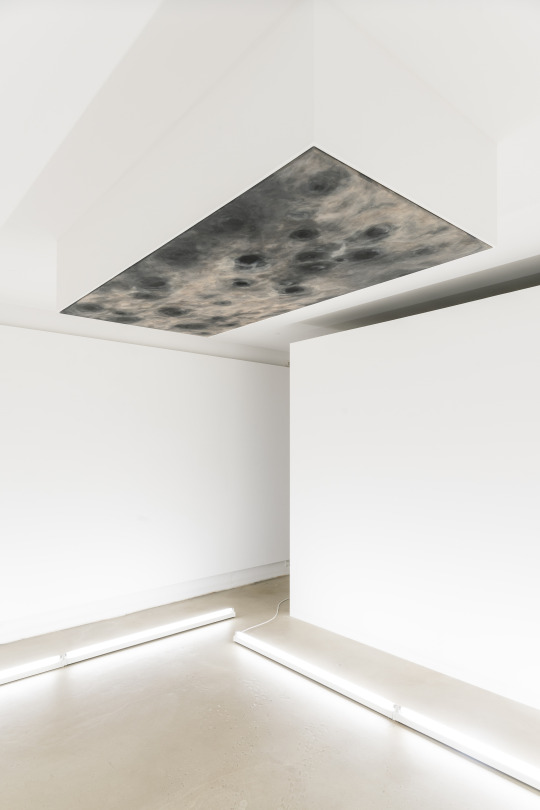#niraltman
Photo

LittleWhitehead - Blackhood, 2018
35 notes
·
View notes
Text
Discussing the group show ‘sensational and anti-generative successions’ @ Nir Altman, Munich (opened 2019-10-25)
Participating artists: Brandon Covington Sam-Sumana, Steffani Jemison, Ndayé Kouagou, Kengné Téguia
Curated by: Cédric Fauq
Conversants: The Bensplainer and Victor Sternweiler ... sitting on a bench at ca. 11 pm, after the opening of the above mentioned exhibition.
The Bensplainer: So, I think it was a good selection.
Victor: Probably the finest show at Nir Altman’s up to date. But it’s a matter of taste.
The Bensplainer: On the other hand, the eccentricity of artists like Ndayé Kouagou and Kengné Téguia allows us to experience some weirdness. Kouagou comes from poetry, thus he’s not a trained visual artist. Nevertheless, there is something genuine about the way he visualized and acted his performance, as well as he presented his sculptures. Yeah, one cannot really say that this performance was somehow new…
Victor: What do you mean with new?
The Bensplainer: There were many 1960s references. The first name which popped into my head is Bruce Nauman, of course. Magda made a further comment, mentioning Samuel Beckett. So, this is the kind of tradition Kouagou seems to refer to, yet interpreting it freely. On a reception level—thus probably only through my eyes and experiences—I also like to see it as an unintentional criticism at analogous performances so popular in Munich: Kouagou didn’t read. He really performed.
Victor: It wasn’t this type of lecture performance.
The Bensplainer: Exactly. Like those by Tris Vonna-Michell some 15 years ago. I find Kouagou’s performance was properly theatrical.
Victor: I don’t think it was theatrical, in the stiff sense performances in the white cube are exercised nowadays, to my perception. It didn’t come as a thoroughly choreographed piece. He reacted to the audience’s reactions and comments in a natural way—call it postdramatic. He probably did it for the 20th time.
The Bensplainer: Isn’t theater ’theater,’ if you perform a piece more than once?
Victor: Even if it was, he performed it very 'leggero.' The reason why I liked it in particular is that most of the white cube performances nowadays don't seem to be informed by what has been happening in theater domain, they come along either as lecture performances or as sacred rituals in dramatic settings—these performances are oftentimes taken too seriously by their originators. The audience is supposed to be quiet and every move feels like an unwelcome interruption.
The Bensplainer: I wrote a message to Magda before, asking about her opinion on the performance, since she had to leave right after.
Magda’s text response: Ndayé was performing his blackness most strongly (or rather the moment I felt my whiteness as part of the all-white audience) was when he said (and I misquote) "I like boundaries - you stand there and I am here." I think he might have also drawn a line with his hands. I wonder whether previous audiences were so homogeneous. What about the Childish Gambino's musical video?
Victor: I don’t know the video in question, but it is funny, because it might have more to do with her general cultural sensibility apperception, than with Kouagou’s performance.
The Bensplainer: Magdalena’s point is interesting, because formally that is consistent: Kouagou was performing with top half naked, only wearing sort of lacerated beige trousers and black sneakers. Gambino’s costume is similar, as he wears some grayish trousers, which could refer to the Confederates' military uniform during the American Civil War. There’s probably a shared symbolism: this might be Magdalena’s suggestion.
Victor: I don’t really buy into that logic by linking gestures in an art performance, say not wearing a shirt, to the notion of origin or even of politics of blackness etc. I find it a very vague link. In that case we could paradoxically link it to Freddie Mercury's persona, as well. I mean, he performed most of his life topless, on stage. But let’s go to the factual description of the performance.
The Bensplainer: Well, in the first part Kouagou came into the gallery space, he carried a plastic white chair, then put it on one side of the invisible stage of the gallery.
Victor: That plastic garden chair is perhaps the most popular design object ever.
The Bensplainer: He turned on some music from his phone. He started moving quite mechanically à la Nauman, tracing a square around the chair on the floor, at first only step by step – 2 steps each side –, then framing it with tape for the audience. That task remained incomplete. Then he sat down on the chair, and stopped the music. So, the performance’s second act started, and it was about him performing his material, randomly moving his body or the chair outside and inside the taped square. He acted in a Beckett-style text.
Victor: Kouagou seemed to improvise it, talking about love, and “I don’t know what I’m doing here” alike, so back and forth. Quite an ironic commentary of him on the bourgeois type of galleries’ audience, I think. But what do you think about his objects?
The Bensplainer: You mean the sculptures, the Untitled (no dates) hanging from the ceiling? These are more problematic in my view. They were stashed between, I think, two layers of A3-sized Plexiglas. On one side there was printed some texts, which echoed what he recited within the performance. Inside the two plexiglass sheets, there were shirts crystalized with resin.
Victor: Then there was the frame jeans jacket, half folded and wrinkled.
The Bensplainer: This kind of visualization is very typical today—Seth Price’s practice comes to mind—as well as this kind of autobiographical attitude.
Victor: What was written on the objects?
The Bensplainer: Again, some statements which recalled the performance, which showed existential frailty.
Victor: Resembling his performance, so to speak.
The Bensplainer: Exactly, like a repetition with difference.
Victor: I liked the way his objects were installed, hanging from the ceiling in that space. There was no wall behind defining their aura. You can generate 360 images when looking at them—a parallax effect. I would like to see them in a real living space situation and I hope nobody installs them close to a wall.
The Bensplainer: They are theatrical in this sense.
Victor: You insist on the term theater, but then we have to talk about Micheal Fried’s rejection of theatricality. I disagree with Michael Fried here.
The Bensplainer: Me too. So, let’s talk about Téguia’s videos.
Victor: I’m really curious about what you have to say about them, because, at an opening like that, there are so many people one happens to know and to greet, so I had to skip them completely. Prior to that, let’s talk a bit about the objects that were put or installed on the floor of the gallery.
The Bensplainer: I don't know really, since those works by Steffani Jamison didn't really catch my gaze.
Victor: The two transparent Plexiglas objects [Untitled (De Appel) (2018)] with a painted gesture on them, as big as a hand. They looked like those floor caution signs 'Danger – Slippery,' but the objects were transparent. I’d love to see that, installed in a non-white cube ambient where people would bump into. There I think of that Barnett Newman quote “Sculpture is what you bump into when you back up to look at a painting.”
The Bensplainer: As every great abstract painter, Newman has a sense for wit. At the same time Jamison's two sculptures may also be seen as a straight translation into Plexiglas of very common trestles, found in every artist's studio. The ironic element is clear to me, but not its pictorial concept though. On the other hand, Téguia's three video installations challenged me. All three were shown on cube monitors (CRT) placed on the floor and the audio got blasted through rather modest loudspeakers. The three works deal with repetition both in moving image and sound. As for the moving images–being a mysterious shadow figure in Times goes by so slowly (2015), a recut of Disney classic Snowhite in Blanche-Neige is my Bitch (2015), or a fragmented reality in Soul Sista x Kameugné (2014)—they are a reflection on Dara Birnbaum's practice, I suppose. Nevertheless, Téguia added complexity to it with the sound. It is not simply about Birnbaum's manipulation of a found object then, but about his own effort to cover some pop songs while dealing with his deafness. Not that personal narratives were here at stake as a statement: instead, the general claim–that we can understand the world logo-centrically–was questioned here. Who's speaking, and how? And who's hearing, and how? The indeterminacy of perception was accompanied by the observer's possibility to engage relationally with the work, picking up the loudspeaker and listening materially to the sound through its vibration.
Victor: Sounds cool. Can't say anything about it. What’s our next drink? …
The Bensplainer: GRAPPA!
#munich#2019#thebensplainer#victorsternweiler#niraltman#ndayekouagou#kengneteguia#steffanijemison#brandoncovingtonsamsumana#cedricfauq#flaschendrehen#barnettnewman#freddiemercury#darabirnbaum#disney#snowhite
0 notes
Photo

AMBIENT AS A METHOD: A LISTENING SESSION
Kalas Liebfried
In his lecture and listening session, Kalas Liebfried will give insights into his methodology and artistic research for recent works like „Ambient for a Silent Forest“ (Pinakothek der Moderne Munich, 2019), „Corps-à-Corps feat. MC Nancy“ (Kunstverein Munich, 2018) and his sound work „Ports in Transition“ for the festival „Movement (1920-2020)“ (commissioned by the Onassis Foundation and the Goethe-Institute Athens, in cooperation with the Lenbachhaus Munich).
Kalas Liebfried’s interdisciplinary works focus on the installative connection of sculptures, objects, composed sound and its performative staging. They emerge from the appropriation, decoding and montage of found footage as a conceptual foundation. His examination of minimal and ambient music opens a path towards an artistic production, which considers environmental and background aesthetics as a dialectic method: the surroundings, the atmosphere – all that, what is considered as obvious and given – assumes a mediating role. Works which arise within this context own a dynamic relation to space: they refer to a specific site and to a poetic thinking space at the same time. In comparison, the time structure of ‘ambient’ is static and enables a de-temporalization. Translating and decoding these spatiotemporal structures into the interplay of diverse media enables the evolution of an ambient methodology. Its intention is to create a singular system, which generates new works, links and intensities through itself involving the recipients as an active and dynamic part.
Kalas Liebfried (born 1989 in Svishtov, Bulgaria) works and lives in Munich, Germany. He holds a degree in Philosophy from the LMU Munich, and studied Sculpture and Time-Based Media with Stephan Huber, Julian Rosefeldt and Alexandra Bircken at the Academy of Fine Arts Munich. Liebfried’s works have recently been exhibited at Pinakothek der Moderne, Nir Altman Gallery (solo), Haus der Kunst and Kunstverein Munich. In 2019 he received the Erwin und Gisela von Steiner-Foundation award and the Bavarian Culture Prize (Kulturpreis Bayern).
Image: Kalas Liebfried Selected Ambient Works 85-92 Installation View © Niraltman 2019.
Organized By Ύλη[matter]HYLE in collaboration with the Athens School of Fine Arts Erasmus+ Project, Creator Doctus, on Artistic Research.
www.hyle.gr
Address: Pireos 1, Omonia square, 2nd floor #7, 105 52, Athens GR. The building is located inside the archway and the space is accessible with the elevator on the ground floor. For any additional information please contact Georgios Papadopoulos from Creator Doctus - [email protected]
0 notes